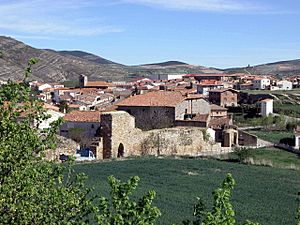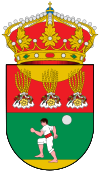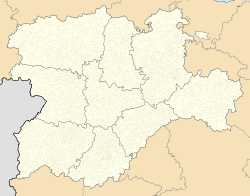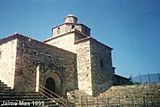San Pedro Manrique facts for kids
Quick facts for kids
San Pedro Manrique
|
||
|---|---|---|
 |
||
|
||
| Country | Spain | |
| Autonomous community | ||
| Province | ||
| Comarca | Tierras Altas | |
| Area | ||
| • Total | 176.20 km2 (68.03 sq mi) | |
| Elevation | 1,177 m (3,862 ft) | |
| Population
(2018)
|
||
| • Total | 617 | |
| • Density | 3.5017/km2 (9.069/sq mi) | |
| Time zone | UTC+1 (CET) | |
| • Summer (DST) | UTC+2 (CEST) | |
| Climate | Cfb | |
San Pedro Manrique is a municipality in the province of Soria, Castile and León, Spain. As of 2009[update], it had 626 inhabitants. Since the mid-nineteenth century this municipality has aggregated smaller villages.
There is a deposit of lead in the municipality.
Villages
- Acrijos
- Armejún
- Buimanco
- Fuentebella
- Vea
- Peñazcurna
- Valdemoro de San Pedro Manrique
- Villarijo
- Matasejún
- Valdelavilla
- Santiago
- Valdenegrillos
- El Vallejo
- Taniñe
- Las Fuentes de San Pedro
- Ventosa de San Pedro
- Palacios
Gallery
History
Until the French Revolution the town was a constitutional municipality in the region of Castilla la Vieja, Soria. In the census of 1842, the town had were 138 homes and 550 residents.
In the 19th century, the municipality expanded to include the localities of Acrijos, Armejún, Buimanco, Fuentebella, Peñazcurna, Valdemoro de San Pedro Manrique, and Villarijo.
In the late 20th century, the municipality expanded to incorporate the localities of Matasejún, Valdelavilla, Sarnago, Valdenegrillos, El Vallejo, Taniñe, Las Fuentes de San Pedro, Ventosa de San Pedro, and Palacios.
As of 1 January 2010 the population was 639 inhabitants, 359 men and 280 women.
Economy
The town is known for the spicy sausage produced there. The area is mainly reliant on livestock, agriculture, food industry (chacinera), hospitality, forestry and local services.
Folk culture
It is known for its unique celebration of the Día de San Juan. During this festival, some women called "móndidas" dress in traditional costume wearing huge "cestaños" (a kind of basket filling stones for stability, and containing a roulade and several rolls), decorated with flowers and three "arbujuelos" (tree branches covered with unleavened bread colored with saffron). On the night of San Juan, known as the Paso del Fuego, a bonfire next to the shrine of the Virgen de la Peña is lit and when it has burnt to embers, the locals remove their shoes and walk barefoot on the lighted embers. It is very possible that these festivals are residue of a pagan pre-Christian holiday, and that the name of móndida comes from Maenad. The event is classified as being of ethnological interest by the Castile and Leon government.
In 2011, a scientific study of firewalking sparked global interest. In this study, the scientists showed evidence of synchronization between the heartbeats of practitioners and spectators at the firewalking ritual.
Landmarks
- Shrine of the Virgin de la Peña
- Romanesque church of San Miguel, with statues of the Apostles
See also
 In Spanish: San Pedro Manrique para niños
In Spanish: San Pedro Manrique para niños
















